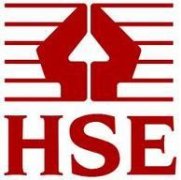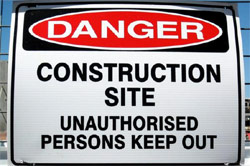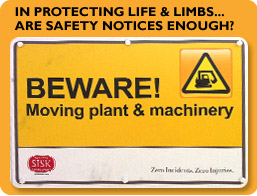Staying Alive While Working At Height Parliamentary Report... Read more »
Woman Dead & Crane Operator In Critical Condition After Crane Folds In London... Read more »
Irish Building site deaths doubled in 2019... Read more »
Balfour Beatty Workers Fall from Scissor-Lift... Read more »
23 year old killed when Dumper Overturns... Read more »
CRH – recorded 10 fatalities in 2017... Read more »
Gary Currie RIP died when un-serviced Access Platform MEWP collapsed from 28m/92ft... Read more »
29 year old Rick Jaeger-Fozard is killed working a Genie Access Platform MEWP for Kimberley Access... Read more »
David Scott Green killed by overturned dump truck - did not have his seat belt fastened as was common on the Colchester site... Read more »
“Frightening Industry Indictments”¯ ... Read more stories here »
Health & Safety
 Over the past two or three years we have seen the emergence of a new phenomenon in which major international contractors - particularly in the UK - issuing safety notices resulting from equipment incidents on sites. These safety notices often impose a temporary ban on certain equipment calling into question their design, even though the incident may have arisen due to their own failings in terms of training or site management.
Over the past two or three years we have seen the emergence of a new phenomenon in which major international contractors - particularly in the UK - issuing safety notices resulting from equipment incidents on sites. These safety notices often impose a temporary ban on certain equipment calling into question their design, even though the incident may have arisen due to their own failings in terms of training or site management.
Rental equipment suppliers squeezed between client and manufacturer - not to mention regulatory standards - are then expected to react instantly and find a solution, hurriedly forcing through technical design changes and modifications of their own. This can be exacerbated by some companies spotting an opportunity to exploit the contractor’s edict to make a quick buck or exclude competitors, but the real problem is the resulting upside-down product development process which rarely produces safer machines.
The safety notices owe more to a knee-jerk, tick-box safety culture and being seen to be doing something, than anything else. They may also be driven by the protracted accident investigations from bodies such as the HSE which can last years, with the threat of legal action hanging over those involved.
The ideal solution would be for the official investigators to produce reports more promptly so product faults or failings are identified and corrected more rapidly, and for contractors to realise that creating a safer site environment is more important that zapping out a blanket safety notice any time a minor incident occurs with a machine. One area where contractors could make a real difference is the reporting of near misses. While they are all eager to jump on alleged machinery failings - particularly with platforms - they are very slow to log and communicate near misses caused in the majority of cases by human error - but which would help improve safety substantially.
In a recent case the upper boom of an almost new articulated boom lift came down on its own accord on a UK site - not that quickly and no one was hurt. The unit was taken back to the rental companyā€™s yard where the incident was replicated. The cause was clearly due to a one-off combination of either cylinder/valve contamination and/or an individual component issue. In spite of this the contractor fired off a safety bulletin to all and sundry, warning that such machines should be stood down. The problem with such grossly exaggerated and premature bulletins is that a ‘cry wolf syndrome’ sets in and bulletins - which should be highly effective safety tools - are discredited.
Surely a more intelligent approach is required?
Mark Darwin
Cranes & Access
Aug/Sept 2013
Source: Cranes & Access
Kosran Comment:
|
. . . . . . . . . . . . . . . . . . . . . . . .
A Glasgow company has been fined £200,000 after an employee was thrown to his death by an overturning powered access platform.
 Mr Leslie Watson, an employee of SW Global Resourcing, was killed while working at the Annick Water Viaduct, Stewarton, Ayrshire, in 2010.
Mr Leslie Watson, an employee of SW Global Resourcing, was killed while working at the Annick Water Viaduct, Stewarton, Ayrshire, in 2010.
He was part of a crew working to cap and grout strengthening rods that had been inserted across the arches of the Network Rail viaduct. This involved work at height using mobile elevated work platforms (MEWPs) positioned on concrete plinths, built to create level working surfaces. The plinths were all built on sloping ground with the front ends of some of the plinths significantly higher than the immediately adjacent ground. However, none of them were built with any end stops or edge protection to stop the MEWPs’ wheels moving.
On 13th April 2010, Mr Watson was working from the basket of a MEWP at a height of approximately 13 metres. The MEWP drove off the edge of the concrete plinth and overturned, throwing Mr Watson from its basket against a column of the viaduct and from there to the shallow river bed. He died at the scene as a result of his injuries.
The case was investigated by the Office of Rail Regulation (ORR) with assistance from the Health & Safety Executive. The investigating authorities found that no suitable and sufficient risk assessment had been carried out for the task and the system of work was unsafe. The accident could have been avoided had reasonably practicable precautions, in particular the use of edge protection, been taken.
SW Global Resourcing Limited pled guilty at Kilmarnock Sheriff Court to contraventions of Sections 2 and 33(1) (a) of the Health and Safety at Work etc. Act 1974 and was fined £200,000.
Source: theconstructionindex.co.uk
. . . . . . . . . . . . . . . . . . . . . . . .
A guide to the safe use of telehandlers in construction has been launched in the UK by the Strategic Forum Plant Safety Group, an industry group charged with providing industry advice on the use of equipment in the UK's construction sector.
The 86-page Safe Use of Telehandlers in Construction guide has been written in response to the number of accidents involving telehandlers - with 765 reported serious incidents in the last 10 years - and because telehandlers are becoming larger, with lifting heights of up to 22 m.
"The idea that it's a little lift truck, and that you can apply little lift truck mentality, no longer applies", said Kevin Minton, senior manager at the Construction Plant-hire Association (CPA), who was involved in creating the safe use guide.
According to Tim Watson, the CPA technical consultant who authored the guidance, three key issues are the planning and management of telehandler operations; training assessments; and familiarisation with machines.
"It's terribly important that we don't just concentrate on just one area. We need to focus on all three", he said, speaking at the launch of the document at the Executive Hire Show (EHS) in Coventry.
He said a lot of accident occurred when telehandlers were working with suspended loads. "It is most important - when you are handling suspended loads the operational management has to go up a notch", said Mr Watson.
In addition to planning of telehandler operations, the guide provides clear advice on issues such as lifting personnel, stating that non-integrated personnel baskets should not be used for planned tasks on site. "We had a lot of debate about this one and in the end we came down to a very definite statement", said Mr Watson.
The safe use guide also goes into some details about the importance of using the correct tyres. Mr Watson cited the case of one contractor who found that 30% of its telehandlers were fitted with inappropriate or non-matching tyres.
Colin Wood, managing director of the CPA, said there was a strong message for rental companies and end users; "Telehandlers are the Swiss army knife of the site...and they are the biggest bit of kit that is rented without an operator. That makes it critical to have dedicated operators.
"They get used as a glorified dumper - and that's when the problems come. Wherever possible, they need to have dedicated drivers."
The publication was prepared by a working group including representatives from the CPA, BITA (British Industrial Truck Association), Merlo, JLG, JCB, Hewden and Select Plant.
The publication can be freely downloaded the CPA and BITA websites at www.cpa.uk.net/p/Telehandlers/ and www.bita.org.uk.
The new document complements the pocket-sized BITA safety booklet Operator's Safety Code for Rough Terrain Lift Trucks (the ‘red book'), which is also offered via the BITA website.
Source: www.khl.com
. . . . . . . . . . . . . . . . . . . . . . . .
The Health & Safety obligations of the owner and hirer of a machine under the Corporate Manslaughter & Homicide Acts 2007 include:
Directors and their companies can now be charged with
– ‘Gross Breach of Duty of Care’
- ‘Disregard for life’
- ‘Recklessness - void of any assessment for safety of operator’
THE SOLUTION EXISTS:
ONLY AUTHORISED USERS OPERATE KOSRAN SECURED MACHINES.
This Financial Times article published on February 15th 2010
Explains what could happen to you and your company.
Click here to view the PDF »
. . . . . . . . . . . . . . . . . . . . . . . .
Clampdown on unsafe construction sites
The Health and Safety Executive (HSE) is planning a month-long intensive inspection initiative aimed at reducing death and injury on Britain's construction sites, particularly during refurbishment, repair and maintenance activities.
 During 2009/10, 42 workers died while working in construction and almost three-quarters of these deaths occurred while they were on refurbishment, repair and maintenance jobs. Because of this, these activities will be the main focus of the latest inspections by the HSE.
During 2009/10, 42 workers died while working in construction and almost three-quarters of these deaths occurred while they were on refurbishment, repair and maintenance jobs. Because of this, these activities will be the main focus of the latest inspections by the HSE.The unannounced visits will begin on 14 February. Last year inspectors visited 2,014 sites and 2,414 contractors. During these visits, inspectors issued more than 350 prohibition notices to stop dangerous work.
A great deal of these notices related to working from height. Falls from height remains one of the most common causes of fatalities and major injuries in the construction sector - with more than five incidents recorded every single day.
Philip White, chief inspector of construction, HSE, said: "A lax attitude to health and safety in one of the more dangerous industries is not acceptable, especially when many of the incidents are completely avoidable by taking commonsense actions and precautions.
"As we've demonstrated in previous years, we will not hesitate to take action if we find poor practice that is putting the lives of workers at risk."
Source: link2portal.com
. . . . . . . . . . . . . . . . . . . . . . . .
The article below provided by PP Construction Safety via the CPA outlinse the prosecution of two trained operators whose actions lead to the fatality of a co-worker.
This case must make all properly trained plant operators alert to the fact that both the Crown Prosecution Service (CPS) and the Health and Safety Executive (HSE) are likely to prosecute when operators' unsafe actions lead to death or serious injury.
Plant operator guilty of manslaughter
Jury finds telehandler operator responsible for death of co-worker. The operator of a telescopic handler on a Kier Western site in Plymouth has been found guilty of causing death by gross negligence. Nigel Herring was the operating a Manitou telehandler in September 2007 when the machine tipped causing the skip it was carrying to strike 20-year-old Reece French causing fatal injuries. The prosecution stated that Mr Herring was trained to operate the machine and breached five ‘golden rules’:
- the telehandler stabilisers were not deployed
- the load was raised above two co-workers
- the machine was moving forward with the boom extended
- the forks were not adjusted to fit skip securing sleeves and
- audible and visual alarms were not acted upon
Character references for Mr Herring called him a ‘gentle giant’ who would have swapped places with victim ‘in a heartbeat.’ Mr Herring will be sentenced in two weeks...
To see why Kosran's products are fit for purpose, click here.

Safety First?
Is it possible for a rental business to focus too much on safety?
By: Kevin Appleton Chairman of Travis Perkins plc & former CEO of Lavendon Group.
“There is a clear understanding in my company that we will never turn down a capital expenditure request that is directed at reducing genuine risk”.
“There is a real cost to workplace injury, and an even higher cost attached to workplace fatalities. This cost can be in providing staff cover, in insurance premiums, in reputation, in site delays and stoppages and, finally, in the trust and engagement of your own staff”.
Visit: International Rental News »

THE IRISH TIMES
Wednesday, November 9, 2016
Dublin District Court
Aer Lingus faces trial over Non-Employee Driver’s Death
Aer Lingus is facing trial on health and safety charges in connection with the death of a driver at Dublin Airport.
John Murray from St
Patrick's Close, Skerries,
Co Dublin, fell from a
loading bay in November
2014. The married father of
two, who worked for
transport and logistics firm
DB Shenker Ireland,
sufferred fatal head injuries.
Following an investigation by the Henlth and
Safety Authority, the airline
is charged with failing to
ensure so far as reasonably
practicable that individuals
who were not employees
were not exposed to risks to
their safety, health or
welfare at a cargo warehouse at Dublin Airport.
The charge goes on to
state that it is alleged Aer
Lingus did not have appropriate measures in place to
protect persons from the
risk of a fall from a height.
lt is alleged the company
regularly permitted or
required drivers to access
and egress the building via
the loading bay itself¯. The
charge states this breached
scction 12 of the Safety,
Health and Welfare at Work
Act 2005, and Mr Murray
died as a consequence.
At Dublin District Court,
Judge John O'Neill granted
the DPP's application for
the airline to be returned for
trial to the Dublin Circuit
Criminal Court, where it will
face its next hearing on
December 2nd.
Author: Tom Tuite
. . . . . . . . . . . . . . . . . . . . . . . .
Health & Safety Building firm fined €35,000 and costs over site injury which paralysed man
A CAVAN-BASED construction firm currently working on London’s 2012 Olympic Stadium has been fined €35,000 and costs after a building site injury which left an employee paralysed from the neck down.
P Elliott and Company Ltd recruited a crane driver’s helper who let a crane lift heavy metal cages over workmen’s heads.
Glynn McKenna, environmental health and safety manager with P Elliott and Company, pleaded guilty on its behalf at Dublin Circuit Criminal Court to conducting unsafe lifting operations at the Clarehall, Malahide Road, Dublin, building site on October 24th, 2006.
The family-run company, which was established in 1942 and has an address at Century Business Park, Dublin Road, Cavan, also pleaded guilty to failing to guard openings on a building site roof.
It has no previous convictions.
Judge Frank O’Donnell imposed a fine of €30,000 on one count and €5,000 on the other.
The judge also ordered the company to pay the State’s legal costs totalling €26,969.30.
Insp Pádraig Early of the Health and Safety Authority revealed that one particular cage, which the helper had attached to the crane with two ties instead of four, disintegrated in mid-air and came to ground ‘like arrow’¯ on top of Slovakian construction worker Marian Smutney (31).
Mr Early told Dara Hayes BL, prosecuting, that the injured man was left paralysed from the neck down after suffering a massive head injury and three fractures to his spine.
Source: The Irish Times
